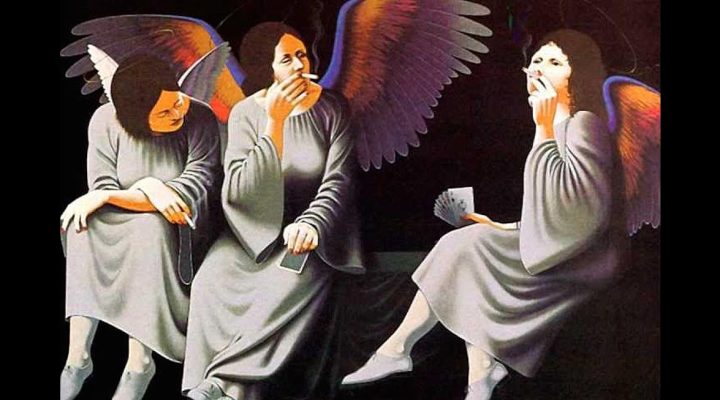What do you believe about the afterlife?
According to the Pew Research Center, most adults in the United States believe in heaven or hell. Specifically, 73% believe in heaven and a few less, 62%, believe in hell.
Three religious categories were considered: Christians, Catholics, and the Unaffiliated (those who identify as atheist, agnostic or “nothing in particular”). Christians show a greater percentage of belief in the afterlife, with 92% believing in heaven and 79% believing in hell. Catholics follow close behind with 90% believing in heaven and 74% believing in hell.
Those who identify as unaffiliated, although not reporting themselves as members of organized religion, have some belief in the afterlife. Of the unaffiliated, 37% believe in heaven and 28% believe in hell. This belief is disproportionately held by the “nothing in particular” subgroup, of which 50% believe in heaven and 39% believe in hell. Half as many agnostics believe in the afterlife, and less than 5% of atheists do.
The survey also considered gender, age, political affiliation, race and region.
As shown by these statistics, not all Americans believe in both heaven and hell. In fact, only 61% of U.S. adults believe in both, while 13% believe only in heaven, and 1% believe only in hell.
“Those who do believe in heaven have specific beliefs about what it will be like when they get there.”
Those who do believe in heaven have specific beliefs about what it will be like when they get there. The most popular belief about heaven is that it will be a place free from suffering. Other common beliefs include believers being able to meet God, having healthy bodies, being reunited or maintaining relationships with loved ones, or becoming angels.
In contrast, people who believe in hell view it as a place of torture or pain. They believe they will experience things like psychological and physical suffering and “become aware of the suffering they created” while alive. Believers think they will not be able to have a relationship with God once they go to hell, but they will be able to meet Satan.
Other beliefs about the afterlife fall beyond the binary concept of heaven and hell. While 26% of U.S adults believe in neither heaven nor hell, 7% of those still believe in an afterlife.
Of these 7% who believe in an afterlife but do not believe in heaven or hell, they describe the afterlife in various ways: 21% believe a person’s spirit or energy continues living on, 17% believe in some form of reincarnation, 11% believe their spirit will cease suffering and be at peace, 8% believe their spirit will “rejoin” the universe, and 4% believe an afterlife is a form of spiritual learning or growth.
So, where do all these beliefs come from?
There are plenty of different religions with differing perspectives on the afterlife, but from a Christian perspective, the biblical text is a bit ambiguous about it. When we survey the Bible, although we may talk about heaven and hell quite often, there is little known about what will happen when we die.
We may look to the word sheol, a word used to describe the ancient place of the dead.
“’The grave’ can be literal or metaphorical, physical or spiritual, so readers have to interpret what they think that means.”
Some Bibles translate the word sheol into the phrase “the grave,” as the NIV does in Genesis 37:35 and other passages including the word. But even this phrase is a bit ambiguous; “the grave” can be literal or metaphorical, physical or spiritual, so readers have to interpret what they think that means.
Unfortunately, there is not a lot of art preserved from ancient Israelite life. So, religious scholars and historians do not have access to ancient depictions of what they believed sheol looked like.
But we do know a bit about the word itself. According to the Jewish Encyclopedia, sheol is a “Hebrew word of uncertain etymology” with Hebrew synonyms for things like “pit” and “abyss” (in English).
Modern conceptions of death and the afterlife, as shown by Pew’s research, are pretty imaginative.
Heaven and hell are separate spaces for those judged as good or bad; one a place of eternal reward, the other of eternal suffering. However, scholars say this is not at all what sheol was thought to be by the Israelites.
Sheol was not hell, nor was there judgment or torture occurring there. Rather, it was a space under the world where the souls of all those who had died congregated.
According to Shawna Dolansky of Carleton University, the use of the term sheol throughout the Hebrew Bible “demonstrates a widespread belief in some sort of dark and dreaded shadowy postmortem existence.” One’s presence in sheol did not denote any sort of morality because the souls of all dead persons went there.
She says it is sometimes described as “watery” or “muddy,” but never as a hot and fiery place of torment sinners must endure eternally, as many Christians believe today. However, despite all the references to sheol in the Hebrew Bible, it is still “difficult to know exactly” how the biblical writers and ancient Israelites understood death, she said.
Given recent research, it appears difficult still today to pin down exactly how modern believers understand the afterlife.

Mallory Challis
Mallory Challis is a senior at Wingate University and serves this semester as BNG’s Clemons Fellow.
Related articles:
Heaven-or-hell theology may be simple, but it is neither biblical nor morally defensible. What’s the alternative? | Opinion by Alan Bean
Pew study offers some surprising insights to American views on suffering, salvation, heaven and hell


